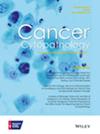Single-cell multiplex immunocytochemistry in cell block preparations of metastatic breast cancer confirms sensitivity of GATA-binding protein 3 over gross cystic disease fluid protein 15 and mammaglobin
Abstract
Background
Metastatic breast cancers are frequently encountered in cytology and require immunocytochemistry (ICC). In this study, traditional and multiplex ICC (mICC) for GATA-binding protein 3 (GATA3), gross cystic disease fluid protein 15 (GCDFP15), and mammaglobin (MMG) were performed with the aim of validating mICC in cell blocks, with further single-cell expression pattern analysis to identify the single markers and combinations of markers most sensitive in subtypes of breast cancer.
Methods
GATA3, GCDFP15, and MMG were paired with OptiView 3,3′-diaminobenzidine and Ventana DISCOVERY Purple and Blue, respectively, with cyclical and serial staining. Bright-field imaging was performed with the Mantra 2 system and analyzed with the inForm Tissue Finder (Akoya Biosciences). Cell detection and phenotyping were further confirmed by two pathologists.
Results
In the 36 cases studied, traditional ICC and mICC demonstrated good concordance (kappa coefficient, >0.5; p < .01) at three cutoffs (1%, 5%, and 50%), except for GATA3 at the 1% cutoff. Single-marker positivity outnumbered double-marker positivity and the exceedingly rare triple-marker positivity (<3%). GATA3 was the leading single marker–positive phenotype in all breast cancer subtypes, except for MMG in estrogen receptor–positive, progesterone receptor–positive, and human epidermal growth factor receptor 2–positive (ER+/PR+/HER2+) breast cancers. Limited to two markers, GATA3/MMG included the greatest number of tumor cells for luminal breast cancers (ER+/PR+/HER2+, 60.6%; ER+/PR+/HER2+, 31.4%), whereas HER2-overexpressed breast cancers (27.4%) and triple-negative breast cancers (26.4%) favored the combination of GATA3/GCDFP15.
Conclusions
For a single marker, GATA3 displayed the highest sensitivity. The addition of MMG for hormone receptor-positive breast cancers and GCDFP15 for hormone receptor-negative breast cancers further increased sensitivity. The low proportion of multimarker-positive cells suggested that the coexpression observed with traditional ICC is attributable to intratumoral heterogeneity, not genuine coexpression.




 求助内容:
求助内容: 应助结果提醒方式:
应助结果提醒方式:


